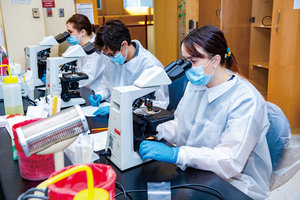The success of the University’s research enterprise will be vital to building its national and international profile and maximizing its economic impact. These goals and strategies aim to reinforce existing research areas, while also exploring those that are emerging. Growing the population of non-teaching faculty researchers, postdoctoral fellows, and Ph.D. students who complete their degree trajectories will be key. Streamlining the research infrastructure will lead to greater competitiveness among faculty and non-teaching faculty researchers for sponsored funding. Lastly, reconceptualizing the arts and humanities, as integral to all human endeavors, will allow for greater and more productive interdisciplinary collaborations.
Achieve national prominence in targeted emerging research areas in a manner that creates movement to the next higher quadrant of Carnegie R1 institutions, while maintaining, enhancing, and leveraging existing areas of strength
Foster a culture of faculty and administrative collaboration that enhances communication and focuses on solving problems and challenges in operating a robust research enterprise
Develop agile processes, tools, and systems to enhance faculty research opportunities, collaboration, and productivity, including greater coordination and support for research infrastructure
Reconceptualize the arts and humanities as crosscutting and integral to all disciplines by connecting scholarship in the arts and humanities with scholarship in science, engineering, health sciences, and other fields
Achieve national prominence in targeted emerging research areas in a manner that creates movement to the next higher quadrant of Carnegie R1 institutions, while maintaining, enhancing, and leveraging existing areas of strength
Foster a culture of faculty and administrative collaboration that enhances communication and focuses on solving problems and challenges in operating a robust research enterprise
Develop agile processes, tools, and systems to enhance faculty research opportunities, collaboration, and productivity, including greater coordination and support for research infrastructure
Reconceptualize the arts and humanities as crosscutting and integral to all disciplines by connecting scholarship in the arts and humanities with scholarship in science, engineering, health sciences, and other fields



